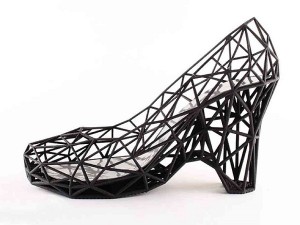The advent of 3D printing

3D PRINTED shoes by the experimental fashion house Continuum makes use of nylon fiber to make the shoe lightweight but strong.
If there’s anything about technology that is both impressive and annoying, it’s that it is constantly evolving at high speed. You have to be on your feet all the time, keeping up with all the improvements in hardware, software plus all associated devices. Some advances benefit only certain industries, but others cross industry borders.
Three-dimensional digital modeling was one of those improvements, revolutionizing the way we visualize and create things. Being able to see our creations in all dimensions and perfect them without producing them into something real just yet, has made the process of design quicker and less costly. And now, technology has leapfrogged with the promise of tangible models through the advent of 3D printing.
I’ve always envisioned the process of 3D printing much like that of carving: starting with a block of some easy-to-cut material that stood still while little robotic blades came slicing and trimming to cut a form, taking bits away and drilling through, quite like the more traditional mechanical machining equipment.
Additive printing
But 3D printing actually works in reverse. It produces objects through a process better known as “additive printing” where the material is first “printed” layer by layer in a particular shape as dictated by its digital model, until it thickens into a three-dimensional figure.
Article continues after this advertisementMost of the time, these layers are produced by extruding melted plastic through fine tubes that run horizontally or vertically through an X or Y axis to create the shape for a particular layer. Much like extruding icing from a tube, or glue from the glue gun. I’ve seen chocolate printers too! Yes, using melted chocolate, extruded layer by layer until it creates a form. Yum!
Article continues after this advertisementWhile 3D printing has only been recently making waves, the technology was actually developed way back in 1986 when inventor Charles Hull filed for the patenting of his “Apparatus for Production of Three-Dimensional Objects by Stereo Lithography,” more popularly known then with the short-cut term “Stereolithography.” The process was essentially a subsequent layering of thin material, slowly creating two-dimensional shapes with the variations in each stratum. Eventually, you get a three-dimensional form.
Completely fascinated
A few months ago, I was completely fascinated by a pair of web-like high-heeled shoes I found online. This pair that I had hoped to order was fabricated via 3D printing. And no, I didn’t order as they were way too expensive, but they piqued my interest on the workings and possibilities of this new medium.
Then just a few weeks back, the same web-like material appeared on a dress modeled by burlesque queen Dita Von Teese. Garbed in the world’s first 3D printed dress, she wore a mesh-like material studded with crystals, with the mesh expanding to suit the outline of her body. This dress wasn’t one of flowing fabric and fine details, but rather an industrial-goth looking get-up in the market, created to demonstrate the capabilities of the modern stereolithography printer to the eagerly awaiting market.
Not surprisingly there are any variants of the 3D printer: some as precise, expensive and clinical looking as modern medical equipment, and others appearing so crude. One model I saw looks much like a photographer’s tripod, and there were others that looked like a student’s science project. Price points vary too, with the pricier of the desktop ones selling at $3,300 to as low as $600! The larger more professional models go for $60,000, and up to $600,000 for one, I hear that can print a substantially sized playhouse.
New technological revolution
In the United States, many are already using 3D printing. In the medical field, doctors recreate bone structures, customize hearing aids and develop models for joint replacements. In the industrial design field, car prototypes, gadget samples and scale models are now easier to create, and can be ready within hours.
Once 3D printing goes mainstream, it will be heralding a new technological revolution. It will make home manufacturing possible, speed up commercial and industrial design, and will definitely spark a new wave of piracy problems.
Interestingly, what is now being developed to complement the printers are 3D scanners, something I tried using in Italy some six years ago, where it was selling for an arm and four legs. But just as soon as 3D printing is being brought to the masses, I’m sure the scanning will be too. It will bring its own set of advantages and issues, but I’m not complaining.
Contact the author through [email protected] or through our Asuncion Berenguer Facebook account.